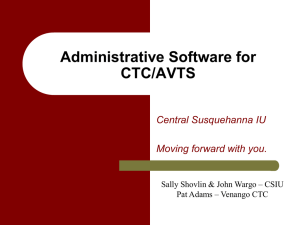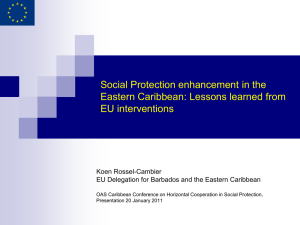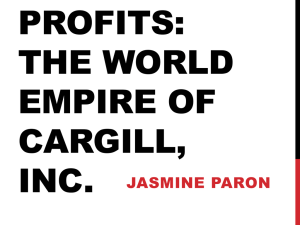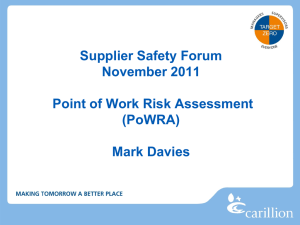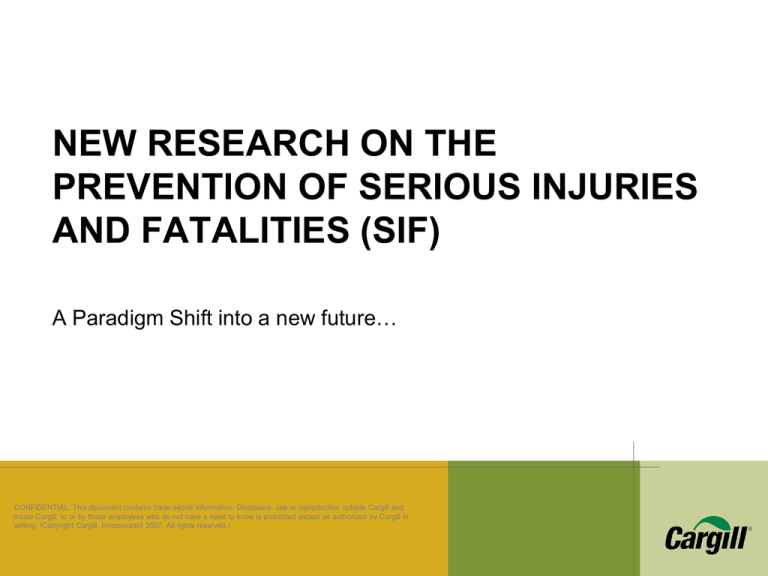
NEW RESEARCH ON THE
PREVENTION OF SERIOUS INJURIES
AND FATALITIES (SIF)
A Paradigm Shift into a new future…
CONFIDENTIAL. This document contains trade secret information. Disclosure, use or reproduction outside Cargill and
inside Cargill, to or by those employees who do not have a need to know is prohibited except as authorized by Cargill In
writing. (Copyright Cargill, Incorporated 2007. All rights reserved.)
Learning Objectives
•
•
•
•
Definition of SIF
Data Trends
Paradigm Shift with Safety Pyramid
Action plan
© 2011 Cargill Incorporated. All rights reserved
SIF = Serious Injury or Fatality
© 2011 Cargill Incorporated. All rights reserved
SIF Research Team
© 2011 Cargill Incorporated. All rights reserved
Industry Data
• FAR – Fatal Accident Rate
• TRIF – Total Recordable Injury Frequency
• LTIF – Lost Time Injury Frequency
© 2011 Cargill Incorporated. All rights reserved
Common for Leading Companies
• Recordable and lost time injury rates are declining steadily, but the
fatality rate is level or increasing
• How can this be? EH&S experts have been telling us for years about
the ‘Safety Pyramid’ The idea that minor injuries predict serious ones
is embedded in our culture
© 2011 Cargill Incorporated. All rights reserved
Definition of Serious Injury
Any injury or illness that resulted in:
Life-threatening injury or illness: one that if not immediately addressed is likely
to lead to the death of the affected individual. Examples include, but are not
limited to:
A. Laceration or crushing injuries or significant blood loss
B. Damage to the brain or spinal cord or Severe burns
C. Use of cardiopulmonary resuscitation or defibrillator
D. Chest or abdominal trauma affecting vital organs
Life-altering injury or illness: one that results in permanent or long-term
impairment. Examples include, but are not limited to:
A. Significant head injuries
B. Paralysis
C. Amputations
D. Broken or fractured bones
© 2011 Cargill Incorporated. All rights reserved
SIF Potential?
Strained Back
Case A (Non-SIF) – Worker was walking across the floor,
slipped on grease, caught himself on a railing, and wrenched
his back (strained back muscle) classified as “first-aid”
Case B (SIF = Yes) – Worker fell from the top of a rail car
when his car was struck by another rail car that was being
moved into position. The worker fell on top of the tank car,
grabbing the guard rail around the dome lid, preventing a fall
to the ground. The only injury resulting was some bruising
and a strained back muscle. Even though this event was
classified as “first-aid”, it clearly has high potential for SIF.
© 2011 Cargill Incorporated. All rights reserved
Not all injuries have SIF
potential
The traditional safety
pyramid is not 100%
predictive of SIF
A reduction of injuries at
the bottom of the pyramid
does not correspond to
an proportionate
reduction of SIFs
21% Potentially
SIF
© 2011 Cargill Incorporated. All rights reserved
Qualitative Analysis
1
2
Theme
SIF or SIF-Potential
Incident
N=55
NON SIF-Potential
Incident
N=35
(Life Safety/Safety Absolute = Policy or Procedure)
%
%
Performing a routine production or a maintenance, connected with a
deviation from an established Life Safety/Safety Absolute
42%
0%
Performing a routine production or a maintenance task connected to
an exposure that changed from a “normal state”, was not
anticipated/recognized/controlled and likely could have been
29%
17%
Self-made human errors that are not connected to a Safety
Absolute Involved in either a routine operations/production or a
maintenance/repair task OR performing a
special/unique/unplanned/emergency situation.
11%
74%
Involved in routine operations/production or a maintenance tasks, and
a connection to an equipment / facility / process / engineering design
flaw has been established
5%
3%
Involved in routine production or a maintenance tasks, and a
connection to predictive & preventive maintenance & inspection,
and reliability systems has been established
5%
6%
4%
0%
4%
0%
prevented by a proper Pre-Task Hazard Assessment (PJHA).
3
4
5
6
7
Involved in a special/unique/unplanned/emergency situation,
connected to an exposure that was unknown or unfamiliar.
Involved in an act or incident or workplace violence, war, or militia
attack or similar.
© 2011 Cargill Incorporated. All rights reserved
You will not reduce SIFs by working
at the bottom of the pyramid alone
(the causes and correlation are different)
Senior leadership attention and
involvement is necessary
(SIF reduction demands a different focus)
Precursors of SIFs can be identified
(and measured)
© 2011 Cargill Incorporated. All rights reserved
Definition of SIF Precursor
A high-risk situation in which management controls
are either absent, ineffective, or not complied with,
and which will result in a serious or fatal injury if
allowed to continue over time
© 2011 Cargill Incorporated. All rights reserved
Examples of Precursors
Precursor: In order to change the doctor roll on a
paper re-roller two workers must stand beneath it
and guide it. The doctor roll weighs about 6 tons
Precursor: A worker is repairing a valve 20-feet
above grade. There is no engineered anchor point to
secure the lanyard
Precursor: During an emergency shutdown
workers are unable to follow all aspects of the
procedure because it appears impractical
These precursors preceded the incidents they are related to.
© 2011 Cargill Incorporated. All rights reserved
Ever heard this before?
• The last 2 years we’ve had a great safety record. Our
recordable rates were lower than ever. We were
proud. A few months ago we celebrated our safety
success
• This quarter we experienced an amputation, a severe
burn, and two frightening near-misses
• Our GM and his boss are upset and confused. Our
safety leaders can’t explain it
© 2011 Cargill Incorporated. All rights reserved
•Bloomington, Illinois
•High audit scores
•No injuries in 6 years
© 2011 Cargill Incorporated. All rights reserved
15
The problem is in the measurement
system that creates a blind spot, not
giving visibility to the events necessary to
see the root cause in order to prevent
SIFs
© 2011 Cargill Incorporated. All rights reserved
The Old Paradigm Revisited
Serious Injuries
and Fatalities
Some of our First Aids
have Precursor’s for
far more serious
injuries..
A focus on the potential for
serious injury
Precursor:
A high-risk situation in which
management controls are either
absent, ineffective, or not complied
with, and which will result in a
serious or fatal injury if allowed to
continue.
© 2011 Cargill Incorporated. All rights reserved
© 2011 Cargill Incorporated. All rights reserved
New Paradigm
• Injuries of differing severity have differing underlying
causes
• The strategy for reducing serious injuries should use
precursor data drawn from all available sources of
data: accidents, injuries, near misses and exposures
© 2011 Cargill Incorporated. All rights reserved
Attack the Pyramids!
Now we will work the
Top!
Precursor:
A high-risk situation in which
management controls are either absent,
ineffective, or not complied with, and
which will result in a serious or fatal
injury if allowed to continue.
Continue to work the
base..
© 2011 Cargill Incorporated. All rights reserved
SIF BU Analysis Information
1800 incidents evaluated from December 2009
through December 2011
437 incidents had SIF potential
This is 24% of our
incidents had SIF
potential!
© 2011 Cargill Incorporated. All rights reserved
SIF Data Breakdown
Near Misses
1421 incidents
321 had SIF potential
23% SIF potential for
Near Misses
© 2011 Cargill Incorporated. All rights reserved
SIF Data Breakdown
First Aid Cases
106 First Aid Cases
20 had SIF potential
19% SIF potential
for First Aid Cases
© 2011 Cargill Incorporated. All rights reserved
SIF Data Breakdown
OSHA Recordables
81 OSHA Recordables
26 had SIF potential
26% SIF potential for OSHA Recordables
• 2 actual SIF injuries
One multiple face fractures when struck by channel iron after a
come along anchor point failed
One steam burn to face, neck and torso when a steam line
failed
© 2011 Cargill Incorporated. All rights reserved
SIF Data Breakdown
Property damage
177 Property Damage Incidents
36 had SIF potential
20% SIF potential with Property Damage
Incidents
© 2011 Cargill Incorporated. All rights reserved
SIF Data Breakdown
Corn Milling Top 6 SIF categories are:
Elevated Work – 84 of 103 had SIF potential
82% SIF potential with Elevated Work
Incidents
© 2011 Cargill Incorporated. All rights reserved
SIF Data Top Six
Falling Equipment – 50 of 67 incidents had SIF potential
73% of Falling Equipment Incidents had SIF
potential
© 2011 Cargill Incorporated. All rights reserved
SIF Data Top Six
Lockout/Tagout – 71 of 113 incidents had SIF potential
63% of Lockout/Tagout Incidents had SIF
potential
© 2011 Cargill Incorporated. All rights reserved
SIF Data Top Six
Rail – 41 of 82 Rail incidents had SIF potential
50% of Rail Incidents had SIF potential
© 2011 Cargill Incorporated. All rights reserved
SIF Data Top Six
Chemical Release – 65 of 140 Chemical
Release Incidents had SIF potential
45% of Chemical Release Incidents had SIF
potential
Chemical Release incidents include Chemical
releases/leaks of acids, caustics, steam and
other operating materials
© 2011 Cargill Incorporated. All rights reserved
SIF Data Top Six
Mobile Equipment – 34 of 107 Mobile
Equipment incidents had SIF potential
32% of Mobile Equipment Incidents had SIF
potential
(This includes all Mobile Equipment except Rail)
© 2011 Cargill Incorporated. All rights reserved
SIF And Contractor Involvement
Contractors were involved in 166 incidents that
had SIF potential
Contractors were involved in 38% of the incidents
that had SIF potential
© 2011 Cargill Incorporated. All rights reserved
Qualitative Analysis - Revisted
1
2
Theme
SIF or SIF-Potential
Incident
N=55
NON SIF-Potential
Incident
N=35
(Life Safety/Safety Absolute = Policy or Procedure)
%
%
Performing a routine production or a maintenance, connected with a
deviation from an established Life Safety/Safety Absolute
42%
0%
Performing a routine production or a maintenance task connected to
an exposure that changed from a “normal state”, was not
anticipated/recognized/controlled and likely could have been
29%
17%
Self-made human errors that are not connected to a Safety
Absolute Involved in either a routine operations/production or a
maintenance/repair task OR performing a
special/unique/unplanned/emergency situation.
11%
74%
Involved in routine operations/production or a maintenance tasks, and
a connection to an equipment / facility / process / engineering design
flaw has been established
5%
3%
Involved in routine production or a maintenance tasks, and a
connection to predictive & preventive maintenance & inspection,
and reliability systems has been established
5%
6%
4%
0%
4%
0%
prevented by a proper Pre-Task Hazard Assessment (PJHA).
3
4
5
6
7
Involved in a special/unique/unplanned/emergency situation,
connected to an exposure that was unknown or unfamiliar.
Involved in an act or incident or workplace violence, war, or militia
attack or similar.
© 2011 Cargill Incorporated. All rights reserved
So now what is the…
© 2011 Cargill Incorporated. All rights reserved
Intervention Design
1. Educate all constituents on the New Paradigm
– Senior Leadership to understand these findings and lead the
effort
2. Measure Serious and Fatal Injuries and SIFPotentials as one category
– Better safety metrics
– Evaluate and judge all incidents based on SIF potential
– Improved tracking of SIF precursor events and progress
© 2011 Cargill Incorporated. All rights reserved
Intervention Design
3. Develop processes to identify
precursors and recommend mitigation
–
–
–
–
–
Study your data
Observations, audit findings, focus groups
Customize to site
Generalize regionally, business unit?
Use BST/ORC findings to start?
© 2011 Cargill Incorporated. All rights reserved
Intervention Design
4. Integrate mitigation efforts with existing safety
systems, and audit & observation processes
•
•
•
•
•
More rigor around cardinal rule situations
Pre-task risk assessment capability
Leverage behavior-based safety system
Verification audits
Rules staying current with equipment, process and
procedural changes
© 2011 Cargill Incorporated. All rights reserved
“W.H.A.T. will keep you safe”
The presentation is now complete!
Any questions?
CONFIDENTIAL. This document contains trade secret information. Disclosure, use or reproduction outside Cargill and
inside Cargill, to or by those employees who do not have a need to know is prohibited except as authorized by Cargill In
writing. (Copyright Cargill, Incorporated 2007. All rights reserved.)



